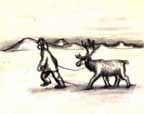


CAS 0370-1007 |
Representational drawings on ivory and bone have a long history among native Alaskan cultures. These traditions were readily adapted to ivory scrimshaw during the Yukon Gold Rush and the heyday of the whaling industry of the late 19th Century. Beginning in the 1920s and 1930s, several Inupiat and Yupik Eskimo self taught artists began drawing on paper and on tanned skins and hides. George Ahgupuk, Robert Mayokok, James Kivetoruk Moses, and Florence Nupok Malewotkuk are widely regarded as the first artists to employ these new media. These artists recorded in pen and ink and/or watercolor drawings traditional lifeways that were quickly changing as natives became increasingly acculturated.
This webpage was originally posted several years ago under the title "Drawn from the Surroundings: The Elkus Collection of Eskimo Paintings" and featured works by the above mentioned artists that had been collected by Ruth C. and Charles de Young Elkus. The original text was excerpted and revised, with the permission of Jonathan Yorba, from his 1990 publication of the same name. In the ensuing years, the Academy has received additional works by several of these artists, and staff has compiled additional information about them, meriting a revision of the entire page.
For background information on a particular artist, works in the Department of Anthropology collection and an associated bibliography, please choose a link below:
![]()
©Native
Alaskan Graphic Arts: Founding Artists content and design
Russell Hartman and Dinah Houghtaling, 2001.